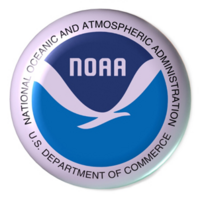National Oceanic and Atmospheric Administration: Difference between revisions
imported>Milton Beychok m (→Office of Oceanic and Atmospheric Research (OAR): Added a subsection) |
imported>Milton Beychok m (Added a new section) |
||
| Line 27: | Line 27: | ||
* Office of Oceanic and Atmospheric Research | * Office of Oceanic and Atmospheric Research | ||
* Program Planning and Integration | * Program Planning and Integration | ||
==National Weather Service== | |||
[[Image:National Weather Service.png|right|thumb|200px|{{#ifexist:Template:National Weather Service.png/credit|{{National Weather Service.png/credit}}<br/>|}}Logo of the National WeatherSeervice.]] | |||
{{main|National Weather Service}} | |||
The National Weather Service (NWS) is responsible for providing "weather, hydrologic, and climate forecasts and warnings for the United States, its territories, adjacent waters and ocean areas, for the protection of life and property and the enhancement of the national economy."<ref>[http://www.nws.noaa.gov/mission.shtml National Weather Service Mission Statement]</ref> This is done through national and regional centers, and more than 120 local weather forecast offices. They are charged with issuing [[weather forecast]]s, severe weather advisories, watches, and warnings on a daily basis. | |||
The NWS issues more than 734,000 weather and 850,000 river forecasts, and more than 45,000 severe weather warnings annually. The NWS operates [[NEXRAD]], a nationwide network of Doppler [[weather radar]]s which can detect [[precipitation (meteorology)|precipitation]] (rainfall). Many of their products are broadcast on [[NOAA Weather Radio]], a network of [[radio transmitter]]s that [[Broadcasting|broadcasts]] weather forecasts, severe weather statements, watches and warnings 24 hours a day. | |||
==Office of Oceanic and Atmospheric Research (OAR)== | ==Office of Oceanic and Atmospheric Research (OAR)== | ||
Revision as of 18:17, 10 October 2008
The National Oceanic and Atmospheric Administration is an agency of the United States government, under the authority of the Department of Commerce.[1]
NOAA works toward its mission through these seven major organizations in addition to several special program units:[2]
- NOAA National Weather Service
- National Environmental Satellite, Data, and Information Service
- National Marine Fisheries Service
- NOAA Ocean Service
- NOAA Research
- Office of Marine and Aviation Operations
- Office of Oceanic and Atmospheric Research
- Program Planning and Integration
National Weather Service
The National Weather Service (NWS) is responsible for providing "weather, hydrologic, and climate forecasts and warnings for the United States, its territories, adjacent waters and ocean areas, for the protection of life and property and the enhancement of the national economy."[3] This is done through national and regional centers, and more than 120 local weather forecast offices. They are charged with issuing weather forecasts, severe weather advisories, watches, and warnings on a daily basis.
The NWS issues more than 734,000 weather and 850,000 river forecasts, and more than 45,000 severe weather warnings annually. The NWS operates NEXRAD, a nationwide network of Doppler weather radars which can detect precipitation (rainfall). Many of their products are broadcast on NOAA Weather Radio, a network of radio transmitters that broadcasts weather forecasts, severe weather statements, watches and warnings 24 hours a day.
Office of Oceanic and Atmospheric Research (OAR)
The Office of Oceanic and Atmospheric Research (OAR)is part of NOAA's research network consisting of 7 internal research laboratories, extramural research at Sea Grant universities, six undersea research centers, research grants funded by the Climate Program Office, and 13 cooperative institutes with various universities.[4]
The research conducted in the OAR laboratories and by the extramural programs focuses on environmental subjects such as hurricanes and tornados, solar flares, the ozone layer, air pollution transport and dispersion, El Niño/La Niña events, ocean currents, fisheries productivity and coastal ecosystems.[4]
Air Resources Laboratory
The Air Resources Laboratory (ARL) is one of the laboratories in the Office of Oceanic and Atmospheric Research.[5] It develops climate and air quality models including the transport, dispersion and removal of air pollutants from the ambient atmosphere. The specific goal of the ARL is to improve the prediction of trends, dispersion of air pollutant plumes, air quality, atmospheric deposition, and related variables.
References
- ↑ National Oceanic and Atmospheric Administration. Department of Commerce. Retrieved on 2007-11-17.
- ↑ NOAA Organizations. Department of Commerce. Retrieved on 2008-01-30.
- ↑ National Weather Service Mission Statement
- ↑ 4.0 4.1 About NOAA research. Department of Commerce. Retrieved on 2008-01-30.
- ↑ Air Resources Laboratory. Department of Commerce. Retrieved on 2008-01-30.
- CZ Live
- Earth Sciences Workgroup
- Chemistry Workgroup
- Biology Workgroup
- Chemical Engineering Subgroup
- Environmental Engineering Subgroup
- Articles written in American English
- All Content
- Earth Sciences Content
- Chemistry Content
- Biology Content
- Chemical Engineering tag
- Environmental Engineering tag
- Engineering Workgroup

